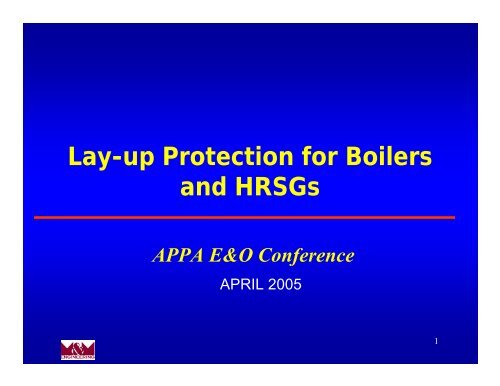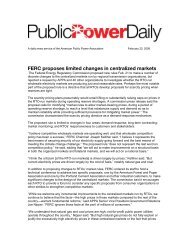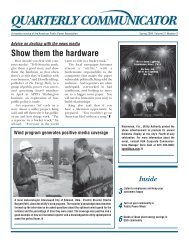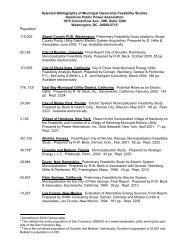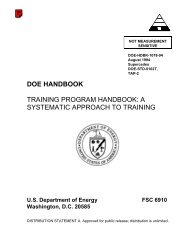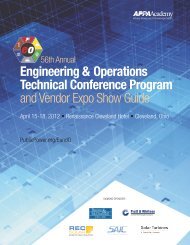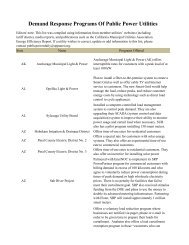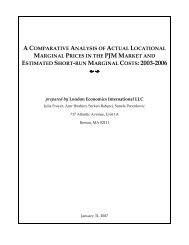Lay-up Protection for Boilers and HRSGs - American Public Power ...
Lay-up Protection for Boilers and HRSGs - American Public Power ...
Lay-up Protection for Boilers and HRSGs - American Public Power ...
You also want an ePaper? Increase the reach of your titles
YUMPU automatically turns print PDFs into web optimized ePapers that Google loves.
<strong>Lay</strong>-<strong>up</strong> <strong>Protection</strong> <strong>for</strong> <strong>Boilers</strong><br />
<strong>and</strong> <strong>HRSGs</strong><br />
APPA E&O Conference<br />
APRIL 2005<br />
1
FOR SALE: 250 MW 2-on-1 Natural Gas Fired<br />
Combined Cycle Plant<br />
Completed in 2000, lightly used, left full of water<br />
with no lay-<strong>up</strong> or preservation.<br />
Make Offer<br />
2
Goals of Proper <strong>Lay</strong>-<strong>up</strong><br />
• Minimize Downtime<br />
Corrosion<br />
• Eliminate Corrosion Product<br />
Transport on Start<strong>up</strong><br />
• Reach Chemical Operating<br />
Limits Quickly<br />
3
<strong>Lay</strong>-<strong>up</strong> the Entire Steam<br />
Cycle!<br />
Vent<br />
HP Turbine<br />
IP<br />
Turbine<br />
LP<br />
Turbine<br />
Condenser<br />
Deaerator<br />
Vent<br />
Boiler<br />
HP<br />
Heaters<br />
LP<br />
Heaters<br />
Condensate<br />
Polisher<br />
4
<strong>Lay</strong>-<strong>up</strong> is Critical <strong>for</strong> HRSG’s<br />
• Cycle frequently<br />
• Faster heating cycles<br />
• Complex circulation<br />
• Often st<strong>and</strong>-alone (no source of aux.<br />
steam)<br />
• Chemical cleaning more complicated<br />
5
Your Choice<br />
Rust <strong>and</strong> Corrosion<br />
6
Your Choice<br />
Passivation <strong>and</strong> <strong>Protection</strong><br />
7
Failure Mechanisms Affected<br />
by Poor <strong>Lay</strong>-<strong>up</strong><br />
• Oxygen Pitting<br />
• Corrosion Fatigue<br />
• Under Deposit Corrosion<br />
– Hydrogen Damage<br />
– Caustic Gouging<br />
8
Oxygen Pitting<br />
Causes:<br />
• Downtime Oxygen<br />
• Dissolved oxygen on<br />
Start<strong>up</strong><br />
• Corrosion Products<br />
Location:<br />
• Anywhere where water<br />
<strong>and</strong> oxygen coexist<br />
9
Oxygen Pitting<br />
• Starts with a deposit<br />
• Driven by oxygen in the water/air versus<br />
no oxygen under the deposit<br />
• Heating increases corrosion rate<br />
• Chloride increases corrosion rate<br />
10
Normal Passivation<br />
Half Reactions<br />
Fe → Fe +2 + 2e - 1 / 2 O 2 + H 2 O + 2 e - → 2 OH -<br />
Fe +2 + 2 OH - Fe (OH) 2<br />
2 Fe(OH) 2 + O 2 Fe 2 O 3 + H 2 O (300 F)<br />
Fe 0 2e -<br />
Fe 2 O 3<br />
O 2 OH -<br />
Fe +2 Fe(OH) 2 Fe 3 O 4<br />
Anode<br />
Steel<br />
Cathode<br />
11
Normal Passivation<br />
R<strong>and</strong>om anodic <strong>and</strong> cathodic sites create a passivation layer<br />
AC<br />
AC<br />
AC<br />
Fe 0<br />
AC<br />
AC<br />
2e -<br />
AC<br />
AC<br />
AC<br />
AC<br />
AC AC AC<br />
AC AC<br />
AC<br />
AC<br />
AC<br />
AC<br />
AC<br />
AC<br />
AC<br />
A- Anode C- Cathode<br />
Steel<br />
12
Oxygen Pitting<br />
Deposits create a localized cathode <strong>and</strong> anode<br />
that <strong>for</strong>m a corrosion pit<br />
High dissolved oxygen<br />
Fe O 2 OH -<br />
2 O Oxygen-deficient area<br />
3<br />
Fe(OH) 2<br />
Anode<br />
Steel<br />
Cathode<br />
13
Corrosion Fatigue<br />
1. Stress cracks protective oxide<br />
2. Oxygen pits <strong>for</strong>m<br />
Fixed point<br />
14
Corrosion Fatigue<br />
Causes:<br />
• Oxygen plus Stress<br />
• DO on start<strong>up</strong><br />
Affects:<br />
• LP Economizer <strong>and</strong><br />
Evaporator<br />
• Fixed points, headers<br />
15
Under-deposit Corrosion<br />
Steam out<br />
Conc. chemicals<br />
Heat<br />
Boiler water in<br />
16
Underdeposit Corrosion<br />
Causes:<br />
• Deposits<br />
• High heat flux<br />
• Improper Chemistry<br />
17
<strong>Lay</strong>-<strong>up</strong> Considerations<br />
Not Time Dependent<br />
Good <strong>Lay</strong>-<strong>up</strong> must work<br />
<strong>for</strong> a day or a year<br />
18
<strong>Lay</strong>-<strong>up</strong> Considerations<br />
Quick return<br />
OR<br />
Scheduled return<br />
19
<strong>Lay</strong>-<strong>up</strong> Considerations<br />
Breech<br />
OR<br />
No Breech<br />
20
Corrosion Triangle<br />
21
Dry <strong>Lay</strong>-<strong>up</strong> — Exclude Water<br />
22
Wet <strong>Lay</strong>-<strong>up</strong> — Excludes Oxygen<br />
23
<strong>Lay</strong>-<strong>up</strong> Options<br />
• Dry <strong>Lay</strong>-<strong>up</strong><br />
– Hot Drain<br />
– Dehumidified Air<br />
– Desiccants<br />
• Wet <strong>Lay</strong>-<strong>up</strong><br />
– Nitrogen<br />
–Steam<br />
24
Design Issues Affecting <strong>Lay</strong><strong>up</strong><br />
• Can all headers <strong>and</strong> piping be drained<br />
completely<br />
• How quickly can it be done<br />
• How accessible are drain valves<br />
25
Design issues: headers<br />
Cannot be drained : Wet <strong>Lay</strong>-<strong>up</strong> only<br />
Dry <strong>Lay</strong>-<strong>up</strong> will work<br />
26
Dry <strong>Lay</strong>-<strong>up</strong><br />
Advantages<br />
• Only option when repairs are required<br />
• Requires less time <strong>and</strong> cost to<br />
maintain<br />
27
Dry <strong>Lay</strong>-<strong>up</strong><br />
Disadvantages<br />
• Need to get systems dry <strong>and</strong> keep<br />
them dry<br />
• Requires considerable time <strong>and</strong> water<br />
on start<strong>up</strong><br />
28
Steps <strong>for</strong> Dry <strong>Lay</strong>-<strong>up</strong><br />
• Drain HRSG hot (some drain<br />
under nitrogen pressure)<br />
• Drain out associated feedwater<br />
equipment <strong>and</strong> piping<br />
• Drain <strong>and</strong> dry out condenser<br />
• Make sure ALL drains are opened,<br />
including header drains<br />
29
Maintaining Dry <strong>Lay</strong>-<strong>up</strong><br />
• Use continuous dehumidified air<br />
circulation<br />
OR<br />
• Close drains/drums <strong>and</strong> use desiccant<br />
30
Dehumidified Air<br />
• Air must circulate though all equipment<br />
• High flows to achieve dew point of – 10F<br />
as quickly as possible<br />
• Continue to circulate 1% system volume<br />
per hour<br />
31
Silica Gel<br />
• Use 5 lbs. silica gel/100 ft 3 of panel volume<br />
• Place in each accessible drum<br />
• Use indicating type<br />
• Check regularly<br />
– At least twice during first week<br />
– Once per week <strong>for</strong> first month<br />
– Once per month thereafter<br />
32
Vapor Phase Inhibitors<br />
• Used on clean metal surfaces<br />
• Addition rate- ~3 lbs per 1000 gallons<br />
capacity<br />
33
Vapor Phase Inhibitors<br />
• Volatile at ambient temperatures<br />
• Destroyed in steam blow or operation<br />
• Treatment can be repeated if needed<br />
34
VPI Preservation<br />
After 30 days<br />
After 106 days<br />
35
Wet <strong>Lay</strong>-<strong>up</strong><br />
Advantages<br />
• Quick restart<br />
• Minimizes corrosion product transport<br />
36
Wet <strong>Lay</strong>-<strong>up</strong><br />
Disadvantages<br />
• Requires freeze protection<br />
• More time <strong>and</strong> cost to maintain properly<br />
37
Wet <strong>Lay</strong>-<strong>up</strong><br />
Hot<br />
or<br />
Cold<br />
•Uses Auxiliary<br />
Steam<br />
• Reduces Thermal<br />
Cycling Stresses<br />
•Faster Starts<br />
• Nitrogen<br />
•Simple to maintain<br />
•No fuel costs<br />
38
Nitrogen Cap<br />
Cap should be applied to:<br />
• Steam Drum(s)<br />
• Deaerator (if separate)<br />
• Condenser<br />
39
Danger:Nitrogen<br />
• Nitrogen lay-<strong>up</strong> is designed to prevent<br />
oxygen from entering the boiler<br />
• Nitrogen will NOT s<strong>up</strong>port life<br />
• All confined spaces MUST be clearly<br />
marked<br />
• Confined Space Entry Procedures<br />
MUST be followed<br />
40
Nitrogen Addition Points<br />
Vent<br />
HP Turbine<br />
IP<br />
Turbine<br />
LP<br />
Turbine<br />
Condenser<br />
Deaerator<br />
Vent<br />
Boiler<br />
HP<br />
Heaters<br />
LP<br />
Heaters<br />
41
LP SH<br />
IP SH<br />
DA<br />
LP Drum<br />
Feedwater Preheater<br />
From HP FW Pump<br />
42<br />
HP Economizer<br />
IP Economizer<br />
HP Economizer<br />
LP Evaporator<br />
IP Drum<br />
To IP Turbine<br />
To LP Turbine<br />
HP Evaporator<br />
HP Econmizer<br />
IP Evaporator<br />
HP Drum<br />
--Nitrogen Addition Points<br />
Drain<br />
Drain<br />
To HP Turbine<br />
HP SH
Nitrogen Cap- Drums<br />
• Enters the drum through<br />
connection on vent line<br />
• Nitrogen feed started while drum<br />
is still hot (~212°F)<br />
• Less than 5 psig of pressure is<br />
applied<br />
43
Nitrogen Cap - Condenser<br />
• Addition starts while while steam<br />
turbine is still spinning down<br />
• Added quickly at first, then slowly<br />
as the vacuum approaches zero<br />
• Constant flow of 20 SCFH is<br />
maintained while the unit is down<br />
44
Wet Chemical <strong>Lay</strong>-<strong>up</strong><br />
• pH of water 9.8 with ammonia or<br />
amines<br />
• Hydrazine or other scavenger may be<br />
added<br />
• Need to circulate <strong>and</strong> test<br />
45
LP SH<br />
IP SH<br />
DA<br />
LP Drum<br />
Feedwater Preheater<br />
From HP FW Pump<br />
46<br />
HP Economizer<br />
IP Economizer<br />
HP Economizer<br />
LP Evaporator<br />
IP Drum<br />
To IP Turbine<br />
To LP Turbine<br />
HP Evaporator<br />
HP Econmizer<br />
IP Evaporator<br />
HP Drum<br />
--Nitrogen Addition Points<br />
--Chemical Sampling Points<br />
Drain<br />
Drain<br />
To HP Turbine<br />
HP SH
Wet Chemical <strong>Lay</strong>-<strong>up</strong><br />
• Requires significant amounts of chemical<br />
• Must add nitrogen or steam provide adequate<br />
protection above the water line<br />
• May create an environmental issue if you<br />
have to drain the HRSG (particularly if<br />
hydrazine is used)<br />
47
Transitions<br />
Dry To Wet<br />
• Need a source of deoxygenated water<br />
• Add chemical treatment during fill<br />
• Cap with Nitrogen<br />
48
Transitions<br />
Wet to Dry (Cold)<br />
• Drain under nitrogen pressure<br />
• Continue to blow nitrogen until water is<br />
gone<br />
• Dry out with dehumidified air<br />
• Use dry air or silica gel to maintain<br />
49
Transitions<br />
Wet to Dry (Better)<br />
• Fire boiler to 25 psig<br />
• Drain under nitrogen pressure<br />
• Dry out with dehumidified air<br />
• Use dry air or silica gel to maintain<br />
50
Start<strong>up</strong> Chemistry<br />
Dry <strong>Lay</strong>-<strong>up</strong><br />
Boiler/HRSG fill-water should be:<br />
•Hot<br />
• Deaerated<br />
• Chemically Treated<br />
51
• Feedwater<br />
Start<strong>up</strong> Chemistry<br />
Treatments<br />
–Amine<br />
– Scavenger<br />
• Boiler<br />
– Phosphate<br />
– Caustic (if needed)<br />
52
Start<strong>up</strong> Chemistry<br />
Wet <strong>Lay</strong>-<strong>up</strong> (Nitrogen)<br />
• Chemistry from the lay-<strong>up</strong> predominates<br />
• Treat with a heavier than normal dose<br />
of amine <strong>and</strong> scavenger to account <strong>for</strong><br />
high make-<strong>up</strong> rates<br />
53
Reference Document<br />
ASME CRTD-Vol. 66<br />
Consensus <strong>for</strong> the <strong>Lay</strong>-<strong>up</strong> of <strong>Boilers</strong>,<br />
Turbines, Turbine Condensers <strong>and</strong><br />
Auxiliary Equipment<br />
Available at the www.asme.org<br />
54


